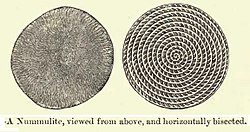Nummulite
| Nummulites Temporal range: Tertiary
| |
|---|---|
| Scientific classification | |
| Kingdom: | |
| Phylum: | |
| Class: | |
| Order: | |
| Superfamily: | |
| Family: | |
| Genus: | Nummulites Lamarck, 1801
|
| Species | |
|
Numerous | |


A nummulite is a large lenticular fossil, characterized by its numerous coils, subdivided by septa into chambers. They are the shells of the fossil and present-day marine protozoan Nummulites, a type of foraminiferan. Nummulites commonly reach 6 cm (2.4 inches) in diameter, and are common in Tertiary marine rocks, particularly around the Mediterranean (e.g. Eocene limestones from Egypt). Fossils up to 6 inches wide are found in the Middle Eocene rocks of Turkey.2 They are valuable as index fossils.

The name "Nummulites" is a diminutive form of the Latin nummulus meaning "little coin", a reference to their shape. In 1913, Randolph Kirkpatrick published a book, The Nummulosphere: an account of the Organic Origin of so-called Igneous Rocks and Abyssal Red Clays, proposing the theory that all rocks have been constructed by the accumulation of forams such as Nummulites.
